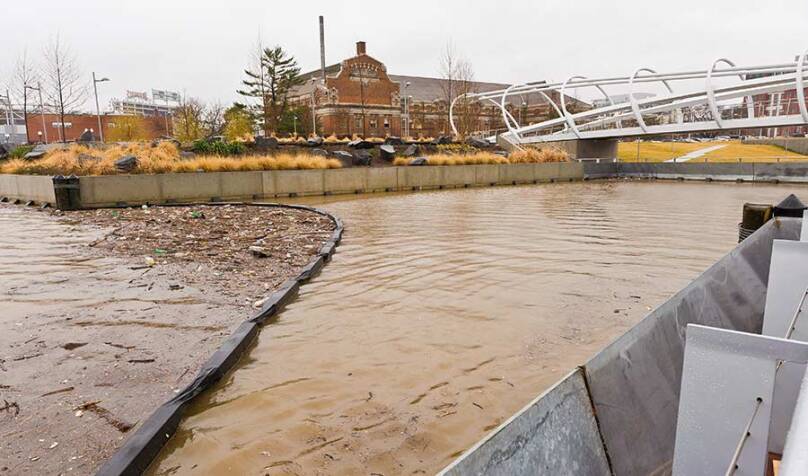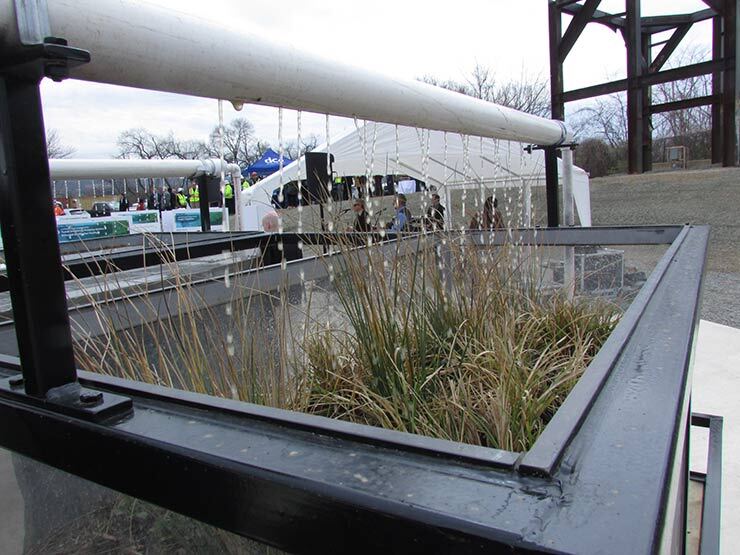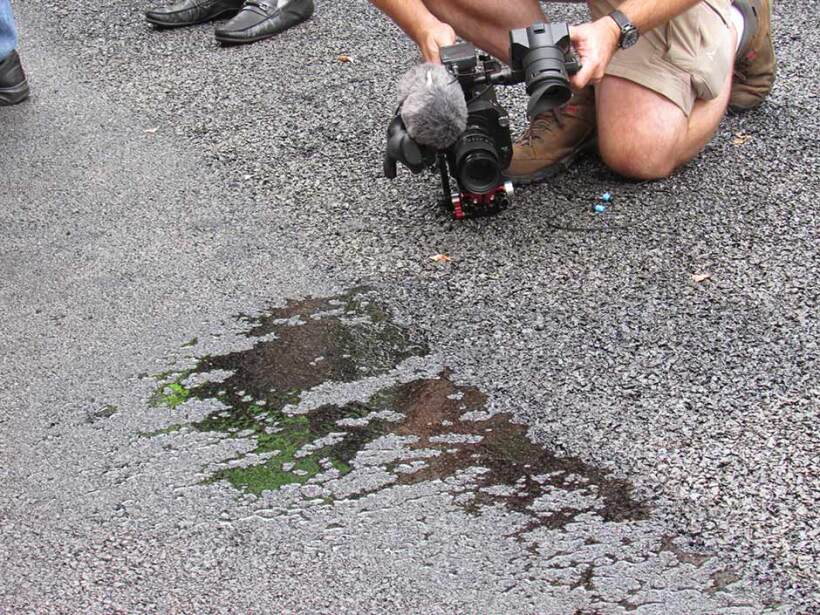Can Green Infrastructure Save America’s Capital from Overflowing Sewage?

Anacostia Riverwalk Trail in Southeast Washington, D.C.
Eric Vance, EPA photographer
(Inside Science) – On the afternoon of March 28, under a cloudy sky threatening rain, Washington, D.C.’s water agency inaugurated what might be called the Great Poop Pipe. The 23-foot-wide, 2.4-mile-long underground tunnel will keep around 900 million gallons per year of waste-laden water -- enough to fill the National Mall’s reflecting pool 132 times -- out of the Anacostia River, the oft-ignored waterway that cuts through the city’s east side.
Dave Ross, assistant administrator for the Environmental Protection Agency’s Office of Water, was on site to celebrate the milestone. Before Washington agreed in 2005 to build the tunnel, he said, such an achievement seemed a far-off dream.
“I thought, ‘How could you ever solve this problem?’” said Ross.
But what the district does next could make it a leader in applying stormwater science. To improve its other two main waterways -- Rock Creek and the more famous Potomac River -- the city’s water agency is installing a mosaic of plantings and water-permeable pavement that will sop up rain before it ever hits the sewers.
In the age of climate change and habitat destruction, urban water quality may seem like a relatively minor environmental problem. But on a day-to-day basis, it makes a lot more difference to city dwellers who have long endured foul smells and been unable to safely swim or fish in their own rivers. That’s because century-old sewers were often built to handle both waste and stormwater -- and to disgorge sewage-laden water into waterways during large rainstorms.
The issue affects more than 770 jurisdictions in the U.S. alone, said Rebecca Stack, an engineer who runs a D.C.-based consulting firm. “It’s not a small problem.”
The new tunnel will route waste-laden water from a major chunk of central Washington -- including some of the city’s most famous sites and neighborhoods -- to the city’s treatment plant on the banks of the Potomac River at the district’s southern tip. The pipe has already performed as promised during a recent storm that dumped two inches of rain over a three-hour period. Further improvements should eventually reduce overflows into the Anacostia to just 4 percent of their past volume.
If all goes as planned, living plants and advanced pavement will make similar improvements in the district’s other two main waterways, getting DC Water out of building two more full-scale tunnels previously required by a court order.

Grasses in a terrarium soak up raindrops from a PVC pipe, demonstrating how green infrastructure keeps stormwater out of sewers.
Image Credit: Gabriel Popkin
Rights: This photo can only be used if published with this Inside Science story
Sponges on the landscape
The plan has had critics, and success is not assured. But if it succeeds, it could help accelerate a new, green era of urban stormwater management around the U.S. and beyond. Cities from New York to Chicago to Seattle are looking to green roofs, roadside plantings, advanced pavement and other innovations to handle what used to be relegated to unsightly and environmentally unfriendly concrete.
“We literally get calls every week from a different community,” said Bethany Bezak, DC Water’s green infrastructure manager. “There’s a lot of interest in seeing what we’ve done.”
A few days after the tunnel opening, I met Bezak alongside a busy street in the northeastern Washington neighborhood of Manor Park. In this landscape, there is little opportunity for rain to infiltrate into the ground; a four-lane-road, paved sidewalks, and rows of attached houses instead shunt raindrops directly into sewers. Some 40 percent of the city is covered in such “impervious” surfaces. And even many areas that should allow rain to permeate, like the verges between roads and sidewalks, have soil so compacted that it absorbs little water.
In one of those verges, six workers poured gravel into a rectangular hole about four feet deep. Bezak explained that this plot would become a piece of “green infrastructure” -- a term for an array of practices meant to capture stormwater without massive outlays of concrete. The workers, who had gone through a first-of-its-kind green infrastructure training program, would later pour finer stone on top of the gravel, then add a sandy soil mix with pores that allow water to infiltrate. Finally, they would plant a mix of native shrubs, flowers and grasses chosen to withstand all manner of urban stresses -- rain, snow, drought, heat and pollution.
We proceeded to a nearby alley paved with brick-sized blocks separated by layers of what looked like tiny pebbles. Below the blocks, I was told, are the same sand, stone and gravel layers that undergird the agency’s plantings. When I poured out my water bottle, water vanished into the spaces between the blocks.
Each installation forms “a little sponge in the landscape,” said Stack, who helped develop the city’s stormwater plan while at the District’s Department of Energy and Environment. During storms, water cascading off of nearby roofs, roads and sidewalks will get trapped rather than inundating the sewer system. The water will then evaporate or trickle into small underground pipes after the main flow has subsided.
Though in a literal sense the pavement is no less grey than a concrete pipe, “it’s green because it’s simulating the natural hydrology before a lot of the city was paved over,” Bezak said.
A historic problem
DC Water’s project represents a new chapter in how cities manage water. Early in their history, cities such as Washington had no sewers at all, creating miasmatic conditions. Over time, cities built underground pipes to channel waste and stormwater into streams and rivers. The practice cleaned up streets and alleys but fouled waterways, so in the early 1900s, cities began building treatment plants and directing sewers there instead.
But many sewer systems couldn’t handle large rains on top of the day-to-day waste of ever-swelling populations. Mixed stormwater and wastewater continued to pour into streams and rivers via built-in outfalls, which function a bit like the overflow holes that keep your sink and bathtub from flooding your bathroom.
One-third of the city -- including much of the area that houses the federal government -- relies on such combined sewers. Washington once averaged more than 3 billion gallons of overflows every year; wastewater spills have been triggered by as little as a fifth of an inch of rain.
In the 1990s, a group of environmental organizations sued the district and the Environmental Protection Agency for violating the 1972 Clean Water Act, which requires that major waterways be “fishable and swimmable.” The city agreed to build tunnels to keep wastewater out of the Anacostia, Potomac and Rock Creek, and construction began on the first of those tunnels.
Alongside the legal wrangling and concrete pouring, however, green infrastructure science was advancing. Researchers designed plantings, green roofs and permeable paving materials, and measured how much water such installations trap and release. A database maintained by the EPA and other agencies has grown to include more than 600 successful projects.
Many studies demonstrating the effectiveness of the techniques were conducted by University of Maryland, College Park engineering professor Allen Davis and colleagues. “Even holding the water for 24 hours can make a difference,” Davis said. “If you get past peak flow, you can store the water and let it out slowly.”
Inspired by green infrastructure’s potential, DC Water advocated for replacing some of the federally mandated tunnels. Initially, environmental advocates worried the agency’s proposal was underfunded and could leave the city with sewers that still overflowed during heavy rains. After further wrangling and a public comment period, however, all sides signed a revised plan in 2016.
The area where I met Bezak is the plan’s first proving ground. Water that falls here flows into Rock Creek, an urban waterway that cuts south through the district and empties into the Potomac. Using computer modeling software developed by the EPA, Bezak and her colleagues determined that they needed to engineer sites to soak up around 12 million gallons of rain -- enough to fill roughly 18 Olympic-size swimming pools -- and release it over the following 24 to 48 hours. That would capture the first 1.2 inches of rain a storm dumps over a 365-acre area, and eliminate sewer overflows into Rock Creek during all but the most severe 10 percent of storms Washington has historically faced.
Bezak doesn’t expect the green infrastructure to reduce the river cleanup’s $2.6 billion price tag. But plantings could deliver more value in the form of wildlife habitat, reduced air pollution, a more beautiful urban landscape and even higher property values, she said.

At a ribbon-cutting for DC Water’s green infrastructure project, demonstrating how green infrastructure keeps stormwater out of sewers.
Image Credit: Gabriel Popkin
Rights: This photo can only be used if published with this Inside Science story
But does it hold water?
Green infrastructure of the kind Washington is deploying has shown that it can stand the test of time, said Robert Traver, a professor of civil and environmental engineering at Villanova University in Pennsylvania. He has maintained a planting of shrubs, grasses and low-lying plants on the campus since 2005. The installation traps more water now than it did when it was new, as growing roots have created water-holding pores in the soil and mature stems and leaves transpire water back into the atmosphere.
What hasn’t been demonstrated, Traver said, is whether cities can maintain dozens or hundreds of pieces of green infrastructure scattered across a large area. “There are a million individual sites,” he said. “I have not seen anyone take a whole city and prove that it works.”
Numerous cities are trying. Seattle began using green infrastructure to manage stormwater in 2013; it aims to keep 700 million gallons a year out of sewers. Philadelphia hopes to eliminate 85 percent of its overflows with green infrastructure alone. Cleveland and Lancaster, Pennsylvania are also implementing projects, according to the EPA.
Washington’s plan is not the largest in terms of volume of water managed, but it is among the most scrutinized. “We certainly have a lot of eyes and ears on D.C,” Bezak said.
After the water agency installs 81 structures in the Rock Creek watershed and 43 more in the Georgetown neighborhood near the Potomac, it will spend a year studying how those sites perform. (A new tunnel, though reduced in size from the 2005 plan, will also keep some wastewater out of the Potomac.) Each installation includes either a ground-level opening or a vertical PVC pipe into which staff can lower cameras and other flow-monitoring equipment.
The district will then send a report to the EPA, which must approve its recommendation to continue with the green-infrastructure project. If the EPA denies approval, the city will revert to conventional sewer pipes.
Environmental advocates are cautiously optimistic. “I feel pretty confident that they’re going to do a good job,” said Becky Hammer, a lawyer at the Natural Resources Defense Council in Washington, who pressed for improvements to the original proposal.
Still, Hammer said, the city could be doing more. A 2007 report
But tunnels are proven, while the scientific foundation for green stormwater infrastructure has some remaining gaps. Cities use computer models to predict the total volume a given structure can hold, but those models don’t always precisely simulate the complex interactions among soil, plants and water, Traver said. “Most models don’t go into depth on how water moves through the system.”
And cities are basing designs on historical rainfall patterns, which will shift as the climate changes. Computer models suggest that the Washington area’s annual precipitation may stay roughly constant, but rain will come in larger, less frequent bursts. Thus, future years could see an increase in what Stack called “big soaker” storms that overwhelm the plantings and pavers the city is installing.
“The open question we and others are working on is really tying the design more to the climate,” Traver said.
The city’s future could depend on how leaders manage this climate-water nexus. Some of the city’s most valuable real estate is just feet above sea level, and computer models have revealed that major storms could conspire with rising rivers to inundate critical federal buildings -- a scenario for which the government is ill prepared.
But the district is working on solutions, as its mayor Muriel Bowser demonstrated at a green infrastructure ribbon-cutting event last October. When Bowser poured a bucket of water onto a spot where high-tech permeable pavement abutted traditional asphalt, the water pooled on the asphalt but disappeared into the spongy pavement.
Soon, billions of raindrops in Washington and cities around the world will perform a similar vanishing act.


